| Home -> Other California History Books -> The Panama Canal at San Francisco 1915 - Text | |||
 |
|||
|
The Panama Canal
At San Francisco Copyrighted 1915 Panama Canal Exhibition Co. Panama-Pacific International Exposition 1915 |
|||
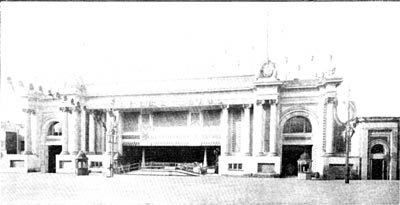 Panama Canal Building on Zone |
|||
The Panama Canal A complete, correct and faithful working reproduction of the Panama Canal and Canal Zone has been constructed at the Panama-Pacific Internalional Exposition in San Francisco, and inasmuch as this Exposition is being held in commemoration of the completion of that great undertaking of this reproduction is of greater interest to the people than an other feature of this great Fair.
A complete, correct and faithful working reproduction of the Panama Canal and Canal Zone has been constructed at the Panama-Pacific Internalional Exposition in San Francisco, and inasmuch as this Exposition is being held in commemoration of the completion of that great undertaking of this reproduction is of greater interest to the people than an other feature of this great Fair.Major F. C. Boggs, chief of the Washington office of the Panama Canal, who inspected and checked this reproduction, reported as follows: The Panama Canal San Francisco, Cal., Feb. 26, 1915. The Panama Canal Exhibition Company, San Francisco, California. This is to advise you that I have completed the checking and examination of your reproduction of the Panama Canal, as arranged with Colonel Geo. W. Goethele, and I find that it is so accurate that it will in half an hour import to anyone a more complete knowledge of the Canal than would a visit of several days to the waterway itself. I am of the opinion, which I think would be shared by the other officials of the Canal, that we would have been very fortunate if we had been present, as the Official Exhibit of the Panama Canal at this Exposition, a reproduction similiar to yours. I am forwarding a copy of this report to Colonel Goethals who, I know, will be glad to learn that you have succeeeded so spendidly in reproducing his great work. I congratulate you on the results you have achieved, and would recommend that everyone should see it. Yours very truly, F. C. Boggs Chief of the Washington Office Panana Canal |
|||
 |
|||
| This magnificent model of the Isthmus of Panama is located near the Fillmore street entrance to the Exposition Grounds and directly adjoins the Machinery Palace. It covers almost five acres, and is the largest reproduction of any subject ever created. Never before has it been attempted to reproduce accurately such a great expanse of territory, representing as it does an area of more than one thousand square miles, with every minute detail worked out with engineering accuracy from plans and drawings furnished by the United States Government, thru the courtesy of the Isthmian Canal Commission and Major General Geo. W. Goethals, now Governor of the Canal Zone. The Panama Canal, the greatest engineering achievement of the age, has aroused the interest of the people of every nation, and during the construction period thousands upon thousands of people traveled from every corner of the globe to see the gigantic undertaking which the United States, in spite of almost insurmountable difficulties, was pushing to completion. There they marveled at the grandeur and immensity of the Culebra Cut, the enormous proportions of the Gatun Dam and the wonders of the lock mechanism. But for every person who was able to visit the Isthmus there were thousands who could not and it was primarily for the benefit of these that this complete working model was constructed. The idea of building this tremendous model was first conceived by a prominent Chicago engineer while on a visit to Panama in 1911, and immediately on his return to the States he had work started on plans from which to determine the possibility of successfully carrying out his conception of what the undertaking should be. More than two years were devoted to designing and planning ways, means and methods for operating the locks, ships, trains and other moving objects, also to provide some method by which it would be possible to satisfactorily explain to each individual spectator the construction and purpose of the Canal, and this, too, in a way that would be easily understood. |
|||
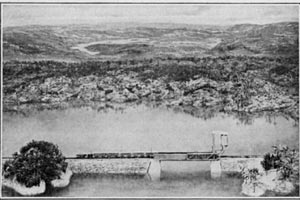 Panama Railroad Train Crossing Gatun River Bridge |
|||
| After many suggestions had been worked out to unsatisfactory conclusions or found impractical, the possibility of a tremendous auditorium, equipped with an individual telephone receiver for each spectator, was investigated and in due time this resulted in the designing of the largest moving platform in the world. This revolving auditorium with its telephonic equipment, the system of traveling magnets which control the movement of the ships, the block system for moving the trains by which the miniature railroad is controlled, and other important features of the reproduction are all new and novel and are therefore herein fully described. Fifteen months before the Exposition was to open construction work was begun at San Francisco on the building which was to house this huge model and at about this time the United States Government first took up the details of its Panama Canal Exhibit. It then developed that the Government also contemplated exhibiting a model of the Canal, although one somewhat smaller in its proportion. Through the Exposition Officials the Government objected to the reproduction of the Panama Canal by private interests and all work was temporarily stopped. Within a short time, however, the Government sent a representative to San Francisco to investigate the plans covering the construction of the reproduction herein described, and as a result of this and numerous conferences at Washington with the Isthmian Canal Commission, the Chairman of The National Exhibit Board, and various other Departments, it was finally decided to allow the construction of the present reproduction to proceed. While there were other factors that influenced this decision, none was so potent and forceful as the fact that the Government was wholly without a method that would enable spectators to be satisfactorily told all that they should know with respect to the Panama Canal, and although the present company offered to step aside and allow the Government to proceed, it was felt that the plan for a revolving auditorium, with telephonic connection, would prove of such tremendous educational value to the people as to warrant the withdrawal of the Government, and so now it is possible for every individual - who has not been able to visit Panama to see and fully understand the great work of our Government. |
|||
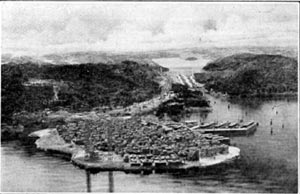 City of Colon with Gatun Lock in the Distance 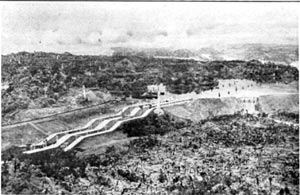 Gatun Locks |
|||
| Almost three months elapsed between the time the Government's objection was filed and withdrawn, so that it was necessary not only to work the greatest number of men possible, but all Sundays and many nights in order to complete this great work in time for the formal opening of the Exposition. The building erected especially to house this great reproduction conforms to the general type of the other Exposition Palaces, being an imitation of Travertine Marble. More than 2,000,000 feet of lumber was used to construct the building and the Canal. For plastering the building and constructing the model, 217 tons of cement and plaster were required, covering approximately ten acres of surface. Within this building there is a large sheltered oblong amphitheatre which surrounds the model, which lies depressed within the walls of the amphitheatre to such a depth as to bring the ocean levels about 20 feet below the spectators, the effect being that of a general bird's-eye view, not only of the Canal, but the territory lying within and adjacent to the Canal Zone. |
|||
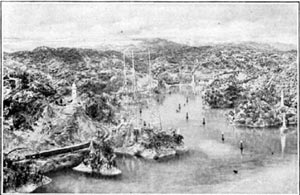 Darien Wireless Station |
|||
| To enhance this general effect the topography thus reproduced is carried out in panoramic perspective upon the vertical walls surrounding the actual territory reproduced, thus giving to the spectator a boundless horizon, miles in extent. The panoramic painting on these walls was done by noted artists and accurately portrays the topography of the Republic of Panama adjacent to the Canal Zone and shows an additional area of approximately four thousand square miles, so that the entire reproduction represents a section of The Isthmus of Panama more than 5,000 square miles in extent. To facilitate the inspection of this gigantic reproduction the revolving auditorium above referred to was provided. It is 1,440 feet in length and so constructed as to encircle the oval depression in which the model was built. This platform consists of 144 cars, each ten feet long, endlessly connected and propelled by electric motors. It is built with one tier of seats above the other and has a seating capacity of 1200 and moves around the model at a speed of eight and one-half (8 1/2) inches per second, consuming about 23 minutes in making the entire circuit. On the moving platform there are 1200 opera chairs, each equipped with a duplex telephone receiver; that is, a receiver for each ear attached to an adjustable handle so that the spectator can hold it to his ears without placing his arms in an unnatural or uncomfortable position. Through these receivers the spectators get a continual lecture as the trip is made around the Canal Zone. The system by which this lecture is delivered was invented and perfected especially for this purpose and consists of a novel combination of phonographs and telephones. This in itself marks a new era in sound reproduction. Sixty phonographs, located in a nearby room, deliver the lecture into telephone transmitters, which in turn transmit it thru a series of wires, rails and various devices to the telephone receivers attached to the seats on the revolving platform. In order to perfect this scheme the wiring of the cars was divided into forty-eight sections, each composed of three cars, and each receiving from the phonographs a different portion of the lecture. Of these forty-eight sections three are always in the area where passengers board and leave the platform and forty-five are always in the lecture area. One phonograph talks to each of these forty-five sections simultaneously, so that of the sixty machines in the phonograph room, forty-five are always in operation and the remaining fifteen are reserved for emergency use. As the platform passes the loading point the passengers step aboard, take seats and adjust the telephone receivers to their ears. Within a moment a metal shoe suspended from the cars on which they are riding makes contact with a rail attached to the ties beneath the cars and the spectators then begin to hear the first record of the lecture. As the platform moves along the metal shoe slides along the contact rail under the cars and as the spectators on the platform hear the last of the first record the metal shoe reaches the end of the first section of rail and passing thru a gap contacts with a second rail thru which the spectators hear the second record of the lecture, and so as the platform moves around the various metal shoes make fifteen different contacts and the spectators hear fifteen different records, which deliver the lecture of some 3000 words. In order to talk to the entire platform at one time it is necessary to have three complete sets or forty-five records, as each phonograph talks to every third section of the platform. One phonograph, for instance having on it the first record of the lecture, talks to sections 1, 4, 7, 10, etc.; another phonograph having the same record talks to sections 2, 5, 8, 11, etc., and a third phonograph with the same record talks to sections 3, 6, 9, 12, etc. After they finish talking to one section the phonographs automatically reset themselves and are started again by the contact which the platform makes with the contact rails beneath the cars. By this system every spectator most listen to a description of that part of the Canal which lies directly in front of him. The idea of reproducing the Canal, as well as the phonographic-telephonic arrangement in conjunction with the moving platform, in fact this entire reproduction, was conceived by L. E. Myers, President of The L. E. Myers Co., Builders and Operators of Public Utilities, Chicago, Ill. The building plans as well as those for all electrical and mechanical equipment were prepared by The L. E. Myers Co., who also handled the construction of this huge reproduction. In the preparation of these plans and all during its construction this work was treated as an engineering problem and not as a theatrical venture, and it is doe to this that such perfect results have been attained. All the mechanical and electrical features here developed are fully covered by patents. By far the most interesting feature of the model is the mechanical operation of the boats, trains, lighthouses, buoys, etc., all of these features being shown in full operation, exactly as they are on the Isthmus. The boats that pass back and forth thru the Canal are controlled by magnets operated on tracks placed beneath the floor of the model, the magnetic influence being exerted thru a 3-inch gap of air, wood, tar, felt, cement and water. |
|||
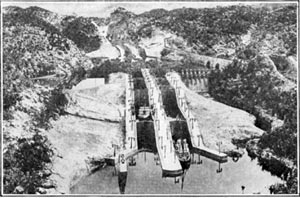 Miraflores and Pedro Miguel Locks |
|||
| At the locks the ships drop the magnets and are towed through the locks by small electric locomotives, the exact counterpart of those used on the Isthmus. A most ingenious mechanism was invented for attaching the tow lines from the locomotives to the vessels in the locks. No mechanism is visible to the spectator, but as if by magic the cables from the locomotives are made fast to the vessels and they are towed thru the locks, exactly as they are in the original. There are trains operating back and forth on the Panama Railroad between Panama and Colon at the same relative speed as the original. They are operated by electricity and controlled from a look-out tower on the roof of the building. In the electrical end of the production there are twenty-one different applications of electricity, such as lighting, power, transportation, telephones and phonographs. Eighty-five miles of copper wire were used and one hundred and four (104) motors were installed. To operate the production seven different voltages are required, varying from 2.4 to 10,000 volts, as well as both alternating and direct current. |
|||
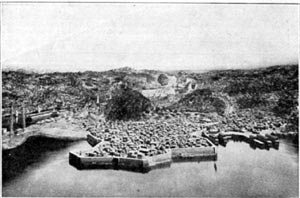 City of Panama |
|||
| The wireless stations at Colon, Balboa, and Darien flash messages to the vessels in Gatun Lake and at Sea and at night the miniature buoys and range towers flash forth their signals to the navigators exactly as they do in the Canal at Panama, and the lights on the boats and in the houses of the cities and villages are gradually lighted, producing a most interesting and attractive effect. Altogether this model of the Panama Canal is the most remarkable reproduction of any subject ever created, of absorbing interest to every man, woman and child and universally conceded to be the greatest attraction at the Exposition. |
|||
|
|
|||